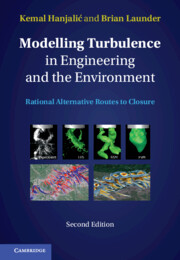Refine search
Actions for selected content:
8126 results in Fluid dynamics and solid mechanics
4 - Introduction
- from Part II - Wave Turbulence
-
- Book:
- Physics of Wave Turbulence
- Published online:
- 08 December 2022
- Print publication:
- 22 December 2022, pp 103-126
-
- Chapter
- Export citation

Physics of Wave Turbulence
-
- Published online:
- 08 December 2022
- Print publication:
- 22 December 2022
7 - Simplified schemes
-
- Book:
- Modelling Turbulence in Engineering and the Environment
- Published online:
- 03 November 2022
- Print publication:
- 24 November 2022, pp 233-292
-
- Chapter
- Export citation
Preface
-
- Book:
- Modelling Turbulence in Engineering and the Environment
- Published online:
- 03 November 2022
- Print publication:
- 24 November 2022, pp ix-xii
-
- Chapter
- Export citation
Contents
-
- Book:
- Modelling Turbulence in Engineering and the Environment
- Published online:
- 03 November 2022
- Print publication:
- 24 November 2022, pp v-viii
-
- Chapter
- Export citation
2 - The exact equations
-
- Book:
- Modelling Turbulence in Engineering and the Environment
- Published online:
- 03 November 2022
- Print publication:
- 24 November 2022, pp 13-32
-
- Chapter
- Export citation
10 - Hybrid RANS-LES (HRL)
-
- Book:
- Modelling Turbulence in Engineering and the Environment
- Published online:
- 03 November 2022
- Print publication:
- 24 November 2022, pp 371-463
-
- Chapter
- Export citation
6 - Modelling in the immediate wall vicinity and at low Ret
-
- Book:
- Modelling Turbulence in Engineering and the Environment
- Published online:
- 03 November 2022
- Print publication:
- 24 November 2022, pp 157-232
-
- Chapter
- Export citation
8 - Wall functions
-
- Book:
- Modelling Turbulence in Engineering and the Environment
- Published online:
- 03 November 2022
- Print publication:
- 24 November 2022, pp 293-331
-
- Chapter
- Export citation
4 - Approaches to closure
-
- Book:
- Modelling Turbulence in Engineering and the Environment
- Published online:
- 03 November 2022
- Print publication:
- 24 November 2022, pp 59-139
-
- Chapter
- Export citation
1 - Introduction
-
- Book:
- Modelling Turbulence in Engineering and the Environment
- Published online:
- 03 November 2022
- Print publication:
- 24 November 2022, pp 1-12
-
- Chapter
- Export citation
Frontmatter
-
- Book:
- Modelling Turbulence in Engineering and the Environment
- Published online:
- 03 November 2022
- Print publication:
- 24 November 2022, pp i-iv
-
- Chapter
- Export citation
Preface to the First Edition
-
- Book:
- Modelling Turbulence in Engineering and the Environment
- Published online:
- 03 November 2022
- Print publication:
- 24 November 2022, pp xiii-xvi
-
- Chapter
- Export citation
Principal Nomenclature
-
- Book:
- Modelling Turbulence in Engineering and the Environment
- Published online:
- 03 November 2022
- Print publication:
- 24 November 2022, pp xvii-xxviii
-
- Chapter
- Export citation
References
-
- Book:
- Modelling Turbulence in Engineering and the Environment
- Published online:
- 03 November 2022
- Print publication:
- 24 November 2022, pp 464-497
-
- Chapter
- Export citation
9 - RANS modelling of unsteady flows (URANS)
-
- Book:
- Modelling Turbulence in Engineering and the Environment
- Published online:
- 03 November 2022
- Print publication:
- 24 November 2022, pp 332-370
-
- Chapter
- Export citation
Index
-
- Book:
- Modelling Turbulence in Engineering and the Environment
- Published online:
- 03 November 2022
- Print publication:
- 24 November 2022, pp 498-506
-
- Chapter
- Export citation
5 - Modelling the scale-determining equations
-
- Book:
- Modelling Turbulence in Engineering and the Environment
- Published online:
- 03 November 2022
- Print publication:
- 24 November 2022, pp 140-156
-
- Chapter
- Export citation
3 - Characterization of stress and flux dynamics: elements required for modelling
-
- Book:
- Modelling Turbulence in Engineering and the Environment
- Published online:
- 03 November 2022
- Print publication:
- 24 November 2022, pp 33-58
-
- Chapter
- Export citation

Modelling Turbulence in Engineering and the Environment
- Rational Alternative Routes to Closure
-
- Published online:
- 03 November 2022
- Print publication:
- 24 November 2022
